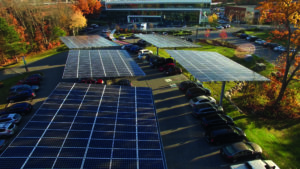The coastal town of Fairfield, Connecticut, has won accolades as one of the best places to live in America. The town’s 5 miles of beach that stretch along the Long Island Sound add to its charm.
But when severe storms pummel the Northeastern seaboard, coastal living in this town can be dangerous and inconvenient. Crushing waves have flooded streets and even destroyed coastal homes in recent years. Along with the wind, rain, and water comes downed power lines and prolonged outages. Townspeople worry about reports that the worst is yet to come — that “storms of the century” are the new norm for residents of Connecticut and across the U.S.
In an effort to proactively mitigate the damage and discomfort caused by future storms, Connecticut is an early leader in microgrid development. Now, if the power goes out, the town’s critical facilities can rely on a microgrid for electricity.
A new energy era
In July 2012, Connecticut’s Governor Dannel Malloy passed legislation demanding an improvement to the state’s emergency preparedness and response efforts. In turn, Connecticut became the nation’s first state to develop a program that funds the development of microgrids at critical facilities.
The Connecticut Department of Energy and Environmental Protection (DEEP) allotted $18 million in microgrid funding to nine municipalities, including Fairfield, in July 2013. Fairfield’s $1.1 million grant went toward the implementation of a microgrid that will sustain operations of police and fire stations and a public shelter, in the event of a natural disaster.
These progressive strides in microgrid development are in line with Fairfield’s reputation for being ahead of the energy curve.
Schneider Electric’s role
Fairfield’s public works department teamed with Schneider Electric in submitting a winning proposal to the state’s microgrid program. The town recognized the expertise and professionalism of Schneider Electric after the company assisted with a water/wastewater proposal. Schneider Electric was a clear choice as a microgrid.
“After seeing the Schneider Electric water/wastewater proposal, I immediately requested that they concurrently provide a municipal (microgrid) proposal,” said Ed Boman, Assistant Director of Public Works. For Fairfield, Schneider Electric installed a microgrid that offers efficient, clean, and reliable energy. The project included:
- An increase in capacity of a natural gas-fired generator from 50 to 60 kW
- The replacement of a diesel-fired emergency generator at the police headquarters with a cleaner-burning natural gas generator
- An electrical connection between the shelter and police and fire stations
- The installation of a 20kW solar photovoltaic rooftop system at the shelter and a 27kW solar photovoltaic rooftop system at the fire station
- A state-of-the-art microgrid controls system
Schneider Electric managed the entire microgrid project from design and construction to installation, training, and technical support.
Efficiency first
The new microgrid ensures that the town’s buildings are served by cleaner electricity in several ways:
- The town swapped out diesel fuel for cleaner-burning natural gas at one of the generators.
- The microgrid incorporates combined heat and power, a highly efficient form of energy that recycles the heat by-product from the power generation process to then provide heating and cooling for other buildings and water.
- The project features a dashboard that displays energy consumption in real time, which allows for precise management of microgrid resources.
- The microgrid harnesses emissions-free solar energy by way of its solar photovoltaic panels.
The bottom line
From adversity – severe storms and power outages – comes innovation. Fairfield’s sophisticated use of energy puts the small town on the cutting edge of energy management and microgrid development, promising lower energy costs and unshakable power reliability that guarantee the town’s energy resiliency under any circumstances.
Learn more about how Fairfield overcame adversity by accessing the full case study



